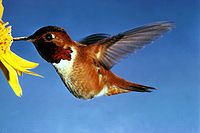
Photo from wikipedia
BackgroundTemperature-driven variation in pollinator assemblage and activity are important information, especially at high altitudes, where rising temperature trends exceed global levels. Temporal patterns of pollinators in a flowering season can… Click to show full abstract
BackgroundTemperature-driven variation in pollinator assemblage and activity are important information, especially at high altitudes, where rising temperature trends exceed global levels. Temporal patterns of pollinators in a flowering season can be used as a proxy to predict the changes of high-altitude plants’ mutualistic relationships. We observed a spring temperature change in one population of a high-altitude endemic species, Megaleranthis saniculifolia on Mt. Sobaeksan, and related it to pollinator assemblage and activity changes.MethodsThis study was conducted at two sites, each facing different slopes (NE and NW), for two times in the spring of 2013 (early-flowering, April 27–28, vs. mid-flowering, May 7–8, 2013). We confirmed that the two sites were comparable in snowmelt regime, composition of flowering plants, and flower density, which could affect pollinator assemblage and activity. Pollinator assemblage and activity were investigated at three quadrats (1 m2 with 5-m distance) for each site, covering a total of 840 min observation for each site. We analyzed correlations between the temperature and visitation frequency.ResultsTwelve pollinator species belonging to four orders were observed for M. saniculifolia at both sites during early- and mid-flowering times. Diptera (five species) and hymenopteran species (four species) were the most abundant pollinators. Pollinator richness increased at both sites toward the mid-flowering time [early vs. mid = 7 (NE) and 3 (NW) vs. 9 (NE) and 5 (NW)]. Compared to the early-flowering time, visitation frequency showed a fourfold increase in the mid-flowering time. With the progression of spring, major pollinators changed from flies to bees. Upon using data pooled over both sites and flowering times, hourly visitation frequency was strongly positively correlated with hourly mean air temperature.ConclusionsThe spring temperature change over a relatively brief flowering period of M. saniculifolia at high altitudes can alter pollinator assemblages through pollinator dominance and visitation frequency changes. Thus, this study emphasizes information on intra- and inter-annual variations in the mutualistic relationship between pollinators and M. saniculifolia to further assess the warming impacts on M. saniculifolia’s reproductive fitness.
Journal Title: Journal of Ecology and Environment
Year Published: 2018
Link to full text (if available)
Share on Social Media: Sign Up to like & get
recommendations!